Guitar pickups might just look like a tiny part of your electric guitar kit, but don’t underestimate their power. They play a major role in how your guitar sings. Ever wonder why your favorite guitarist’s sound is so distinct? A big chunk of that magic comes from their choice of pickups. In this guide to the best pickups for your electric guitar kit: choosing the right tone, we’ll break down how different pickups shape your sound — and help you find the perfect match for your build.

Now, you might be asking, do pickups really matter for tone? Absolutely. The pickups translate the string vibrations into electrical signals, crafting the unique character of your guitar’s voice.
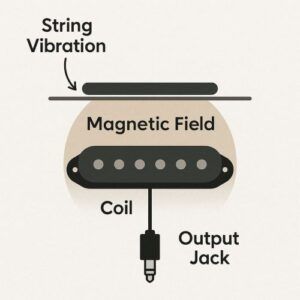
This means they’re kind of like the vocal cords of your instrument.
- Different pickups produce radically different sounds. Love the warm, mellow tones of classic rock? Or maybe you’re into the sharp, twangy vibe of country music? Either way, there’s a pickup tailored to meet your style. Navigating through the types can be pretty fun and enlightening.
- Diving into the basics, you’ll find single coils, with their bright, crisp character, and humbuckers, known for a thicker, richer sound, at opposite ends of the spectrum.
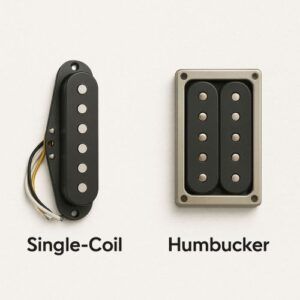
But there’s a world of variety beyond these basics.
- Remember, the choice of pickups isn’t just about the sound itself, but how it feels when you’re playing. It’s about channeling your inner rock star and letting the music speak for itself.
** Here’s a little transparency: Our website contains affiliate links. This means if you click and make a purchase, we may receive a small commission. Don’t worry, there’s no extra cost to you. It’s a simple way you can support our mission to bring you quality content.**
As an Amazon Associate, I earn from qualifying purchases.
Choosing the Right Guitar Pickup: Tailoring Your Sound
Picking guitar pickups ain’t just about grabbing the first set you see; it’s a bit more personal. These little guys are your ticket to shaping your sound in a way that best fits your musical journey.
- First off, think about the style of music you’re into. Are you shredding heavy metal solos or strumming mellow blues? Each genre has its ideal pickup type that’ll help you get that sweet spot in sound. Generally, if you’re rockin’ hard, you might consider high-output pickups for power-packed tones. For softer genres, low-output pickups can bring out those subtle tonal nuances.
- But let’s make it simple: how do you actually choose the right pickup? Start by considering the core tone you’re aiming for. Chart down if you lean towards brighter, sharper sounds, or if the deep, warm tones are your jam.
- Another thing people often overlook is pickup output levels. High-output pickups push the amp harder, giving that extra grit and sustain — think thrashy rock or roaring metal.

Low-output pickups offer more clarity and subtlety, awesome for jazz or clean blues.
- Also, consider the pickup’s magnet, as it influences the sound. Alnico pickups offer a warmer, vintage sound, while ceramic pickups are generally hotter, with more pressure-packed vibes.
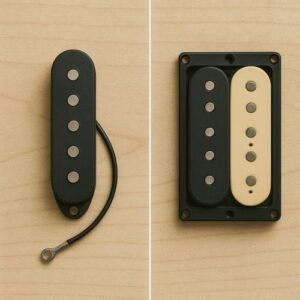
You’ll find it impactful once you get into the groove and feel what suits your play style.
Navigating these choices, and maybe trying out a few setups, can really help you zero in on the perfect pickup fit. Remember, selecting pickups isn’t just about the technicalities — it’s about connecting with your guitar on a deeper level and expressing your unique musical voice.
Pickup Position: A Key Factor in Tone Transformation
Pickup position might seem like just a technical detail, but trust me, it makes a huge difference in shaping your sound.
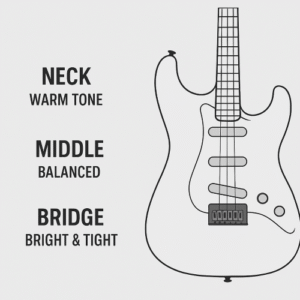
The location of your pickup dramatically influences what kind of tones your guitar can produce.
So, you’re curious if pickup position really affects tone? It sure does. Consider the neck pickup. Its position close to the center of the string’s vibration results in a warmer, sweeter sound. It’s perfect for creamy solo tones or smooth jazz licks.
Now, slide down to the bridge. This pickup is all about focus and precision, producing sharper, snappier sounds ideal for cutting through a full band mix. That’s why folks who play leads often favor it for its punchy tone.
Then there’s the middle pickup, often part of the unsung hero in three-pickup setups. It can strike a balance between the neck and bridge, offering a unique blend of warmth and brightness. It’s a great choice when you’re looking for versatility.
Examples of three-pickup setups:

- SSS – three single coil pickups
- SSH – two single coil pickups and one humbucker pickup
- HSH – one humbucker – one single coil – one humbucker
Experimenting here can be so much fun. Try different combinations if you have a multi-position switch. Explore mixing positions, blending neck and bridge for a broader range of sounds. Remember, it’s your chance to find what resonates with you.
Ultimately, it all comes down to… personal preference and the particular tone you’re aiming to highlight. Switch it up and find your sweet spot — your perfect position might just surprise you.
Single Coil vs. Humbucker: The Great Pickup Debate
When it comes to pickups, single coils and humbuckers often stand in opposition, each offering their own unique flavor to your sound. Deciding between them depends a lot on what you’re hoping to achieve musically.

- Single coil pickups are the go-to for sharp, defined tones. They excel in genres like blues and funk, where crisp, bright sounds are a big part of the experience. Their clean, clear sound is a favorite for rhythm playing that’s intended to stand out.
- On the flip side, humbuckers dish out a thicker, beefier sound. Known for their noise-canceling ability, these pickups are a staple in rock and metal. You can crank up the gain without fear of pesky feedback. They let solos soar without a buzz kill.
- So, you might wonder, which is better, single coil or humbucker? Well, it totally hinges on your personal sound preference and the style you love. If you play a mix, having a guitar with both types of pickups might give you the flexibility to adapt as you jam.
- Keep in mind, it’s never about one being better than the other, but about which resonates more with your vibe. Playing different styles or genres might mean exploring both types and seeing how they change your music’s color and dynamics.
Ultimately, whether you’re sticking with the known or thinking about mixing things up, choosing pickups is all about finding your voice. Go ahead, let your guitar sing in a way that’s true to you.
***Conclusion…
Choosing the right pickups is key to unlocking the full tonal potential of your electric guitar kit — but it’s only part of the equation. If you haven’t already, check out our step-by-step guide on how to install pickups in your guitar kit to make sure you’re setting them up properly. For those ready to dive into electronics, don’t miss our walkthrough on wiring your kit for optimal performance. You’ll also want to ensure your build is structurally sound by following our advice on setting up the bridge and neck. If you’re just getting started, take a look at tools you’ll need to build your kit. And when problems pop up — as they sometimes do — our guide to common troubleshooting issues has you covered. The right tone starts with the right choices across every step of your build.
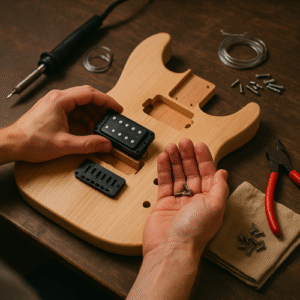
There are 100’s of ways you can build a business around your passion for guitar building.
Check it out…

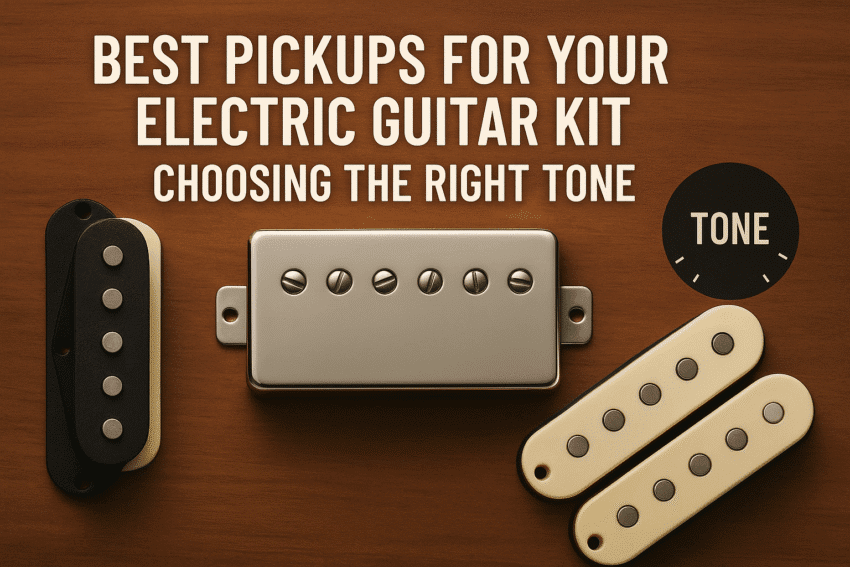

This is such a well-rounded guide to pickups! I love how you break down the impact of pickup type, output, magnet material, and even position on tone. It really shows how personal and nuanced choosing pickups can be. The reminder that blending different pickups (like in HSH or SSH setups) offers so much tonal flexibility is spot on.
A couple of questions for you:
When experimenting with pickup combinations, have you found any surprising blends that work well across multiple genres? For someone building their first kit, do you recommend starting with one type of pickup and upgrading later, or investing in a versatile combo right away? Also, how much does the wiring and electronics setup affect the tone compared to the pickups themselves?
Thanks for sharing this—it’s a great resource for anyone diving into guitar builds! ~Leahrae
Thanks so much, Leahrae! I’m really glad you found the guide helpful. Pickups are definitely one of the most fun (and complex) parts of shaping your guitar’s voice. Great questions, too! One combo that surprised me was pairing a lower-output vintage-style neck humbucker with a hotter bridge single coil… great balance and super versatile across blues, indie, and even light rock. For first-time builders, I usually recommend starting with a versatile setup like HSS or SSH. It gives you a wide tonal range without needing immediate upgrades. And yes, wiring and electronics definitely play a big role; things like pot values, cap types, and even wiring style (like 50s vs modern) can subtly but meaningfully shift your tone.
It’s all part of the fun!
Thanks again!
I really enjoyed this guide @Wayne. Clear, practical, and full of tone-shaping wisdom. I came to guitar late in life thanks to my son, who plays beautifully and sparked my curiosity. He is a natural, I am not. Learning about pickups has been a whole new world for me, and your breakdown helped connect the dots between tone, style, and setup. Thanks.
The idea that pickups are like the “vocal cords” of the guitar really stuck with me. It’s surprising how much nuance they bring to the sound—and how personal the choice can be.
I really appreciate the clarity you provided and the clear passion behind this post!
MarkA
Thanks so much, Mark! I’m really glad the guide helped make the pickup puzzle a little clearer. That “vocal cords” idea is one of my favorite ways to explain them, because it really drives home how much personality they give a guitar. It’s awesome that your son inspired you to pick up the instrument—natural talent or not, the fact that you’re exploring and learning is what matters most. Pickups can be a rabbit hole, but a fun one, and I’m happy to hear this breakdown made the connections between tone, style, and setup click for you. Keep playing, keep experimenting, and enjoy the journey!
~Wayne
Fantastic guide! I really appreciate how you break down the impact of pickup type and position—it makes it so much easier to understand how to shape tone.
Quick question: for someone building a versatile kit meant for both blues and rock, would you recommend starting with a mix of single coils and humbuckers, or sticking to one type and experimenting with position and output instead?
Thanks so much! I’m glad the guide made pickup type and position easier to grasp. For a versatile blues-and-rock kit, a common approach is to mix single coils and humbuckers. This gives you bright, snappy tones for blues and thicker, warmer tones for rock. Another option is sticking to one type and experimenting with position, height, and output; it can simplify wiring and still cover a lot of ground. It really depends on whether you want maximum tonal variety or a more streamlined setup.
Either way, playing around with position and output can really help you dial in your ideal sound.
Thanks again,
~Wayne